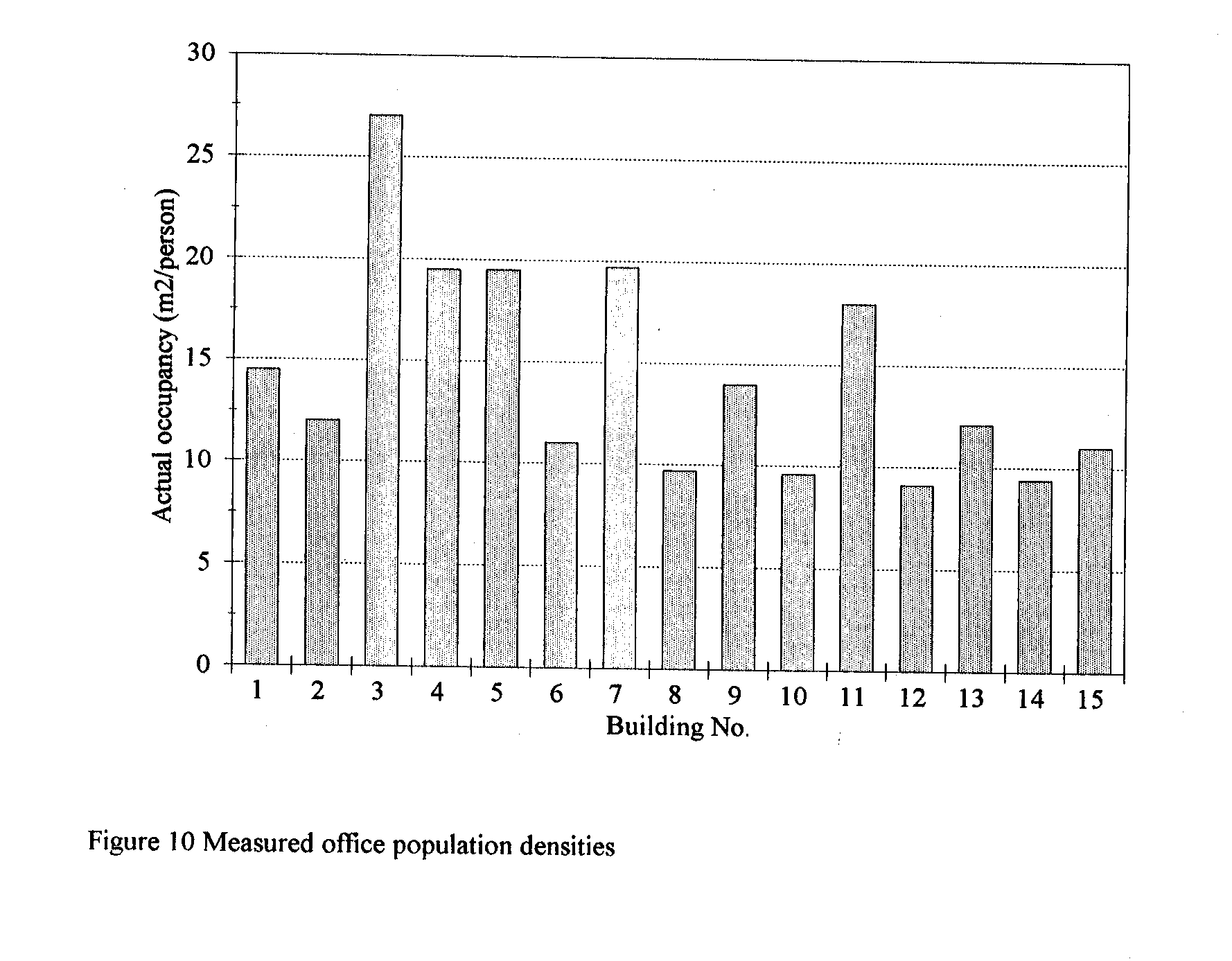Green Lifts?
R D Peters
Brunel University
Arup Research & Development
Proceedings of CIBSE National Conference 1994 (The Chartered Institution of Building Services Engineers)(1994). Republished by Elevator World (June 1995) and by Elevation (Autumn 1995). At the time of writing Richard Peters was working for Ove Arup & Partners, and enrolled on the Engineering Doctorate program at Brunel University. This web version © Peters Research Ltd 2010.
In this paper, the author reviews his current doctoral research project in which he is investigating ways of reducing the environmental impact of vertical transportation systems. Life Cycle Analysis is used to demonstrate that electrical energy in use is the dominant cause of environmental impact for a typical office lift system. Three areas of research are described which are intended to reduce this energy in use. These are: (i) Modelling lift movement and corresponding energy consumption as a means of reducing the energy consumption associated with lift trips, (ii) Review of current lift traffic design criteria so we can design systems that reduce energy usage based on actual traffic flow as opposed to hypothetical peak traffic flow, and (iii) developing an approach to writing lift control algorithms which incorporates ways of reducing the energy consumption associated with transporting passengers.
Introduction
Is there such a thing as a “green” lift? Can we design a lift system that delivers good passenger service at an acceptable cost while incurring minimum environmental impact?
In this paper, the author reviews his current doctoral research project in which he is investigating ways of reducing the environmental impact of vertical transportation systems. The discussion begins with Life Cycle Analysis which enables us to quantify the environmental burdens associated with a product or process. An approach to reducing the environmental burdens associated with lift systems is proposed.
Quantifying environmental burdens
Life Cycle Analysis
If we are to make claims about environmentally friendly lifts or more generally, vertical transportation systems, we first need to have some measure of environmental burdens. The science of assessing environmental impact is still in its infancy. However, increasingly companies are quoting and applying Life Cycle Analysis (LCA), also known as Cradle to Grave Analysis, as a way of assessing environmental impact.
The aim of LCA is to quantify the environmental burdens of a product or process during its entire life cycle. A LCA considers components such as:
- Resource extraction of materials for manufacture
- Manufacture and installation
- Use of product
- Re-cycling and re-use
- Waste
- Transportation at all stages
The LCA approach is very good at identifying the key environmental burdens associated with a product or process. For example, reference (1) reports:
- In studies one washing powder manufacturer has determined that 80% to 90% of the energy used in washing clothes is used once the powder has left the factory, in heating up water in the washing machine. A combination of washing powder and machine that used cold water could therefore be marketed as a truly green laundry product.
- It can be shown that the environmental burdens associated with transporting goods for re-cycling can sometimes outweigh the benefits of re-cycling the product in the first place. This type of evidence led the Danish government to lift its ban on non-refillable containers.
Lift system LCA
So, what are the environmental burdens associated with moving people up and down buildings? As an example, let us consider a hypothetical eight floor, four lift system manufactured and installed in the United Kingdom, (2) whose life cycle could be represented diagrammatically as shown in Figure 1.
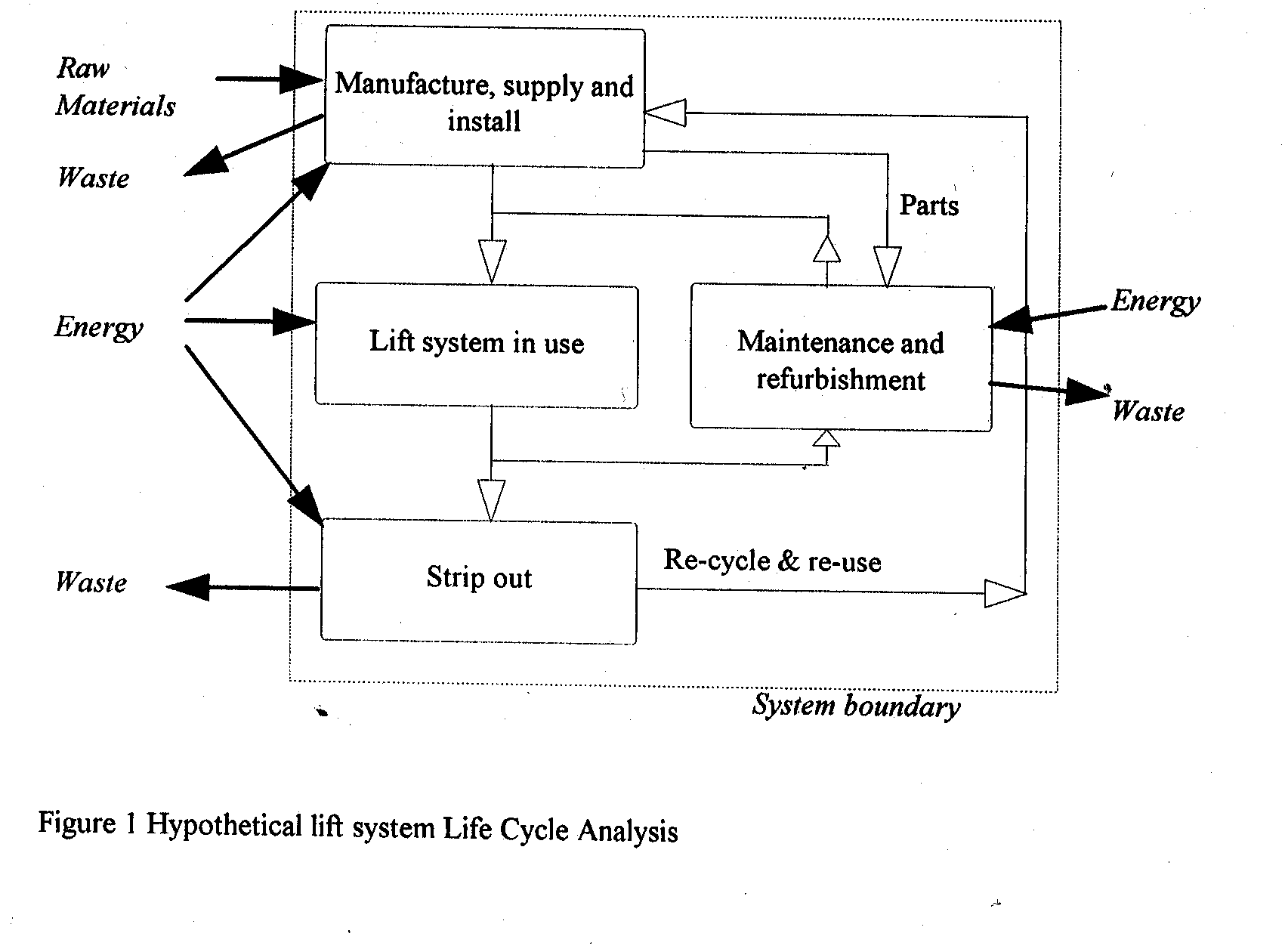
A computer database from PEMS Life Cycle Analysis program (3) has been used to analyse this lift configuration. Results are summarised graphically in Figure 2.
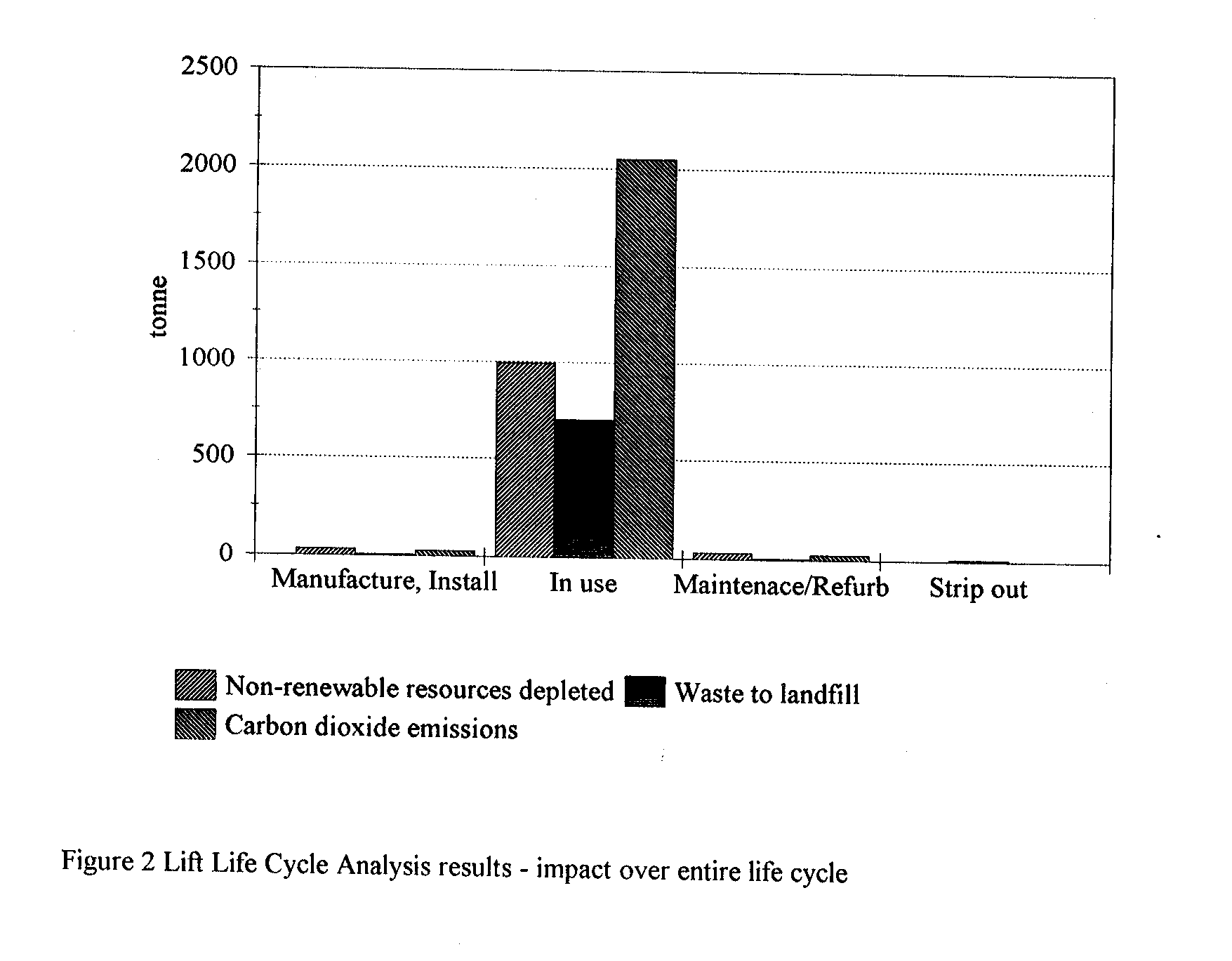
The dominating environmental burdens in the life of this hypothetical lift system are the non-renewable resources depleted, the waste created and the emissions generated through the production of electricity for operation of the lifts while in use. The author suggests this will be typical for the vast majority of lift systems.
Use of renewable resources in manufacture, recycling and re-use, efficient transport, disposal/spillage of hydraulic oil, etc. are all important, but secondary issues, Alone they cannot be the basis of claims for a green lift installation.
Reducing the environmental impact of lift systems
At this stage of research, it is appropriate to concentrate on reducing the dominant source of environmental burden, the lifts’ energy consumption during operation. The draft CIBSE Energy Efficiency Guide (4) suggests lifts and escalators account for between 4% an 7% of a building’s total electricity consumption, and that energy saving measures could in some instances reduce consumption by up to 25%. The author’s current research focuses on three main approaches intended to realise a reduction in energy consumption without compromising performance. These are:
- Modelling lift movement and corresponding energy consumption as a means of reducing the energy consumption associated with lift trips.
- Review of current lift traffic design criteria so we can design systems that reduce energy usage based on actual traffic flow as opposed to hypothetical peak traffic flow.
- Developing an approach to writing lift control algorithms which incorporates ways of reducing energy consumption associated with transporting passengers.
Modelling lift movement and corresponding energy consumption
The ‘ideal’ motion or kinematics of lifts has been discussed by numerous authors (6) (7) (8). A summary is provided in the CIBSE Guide D, ‘Transportation systems in Buildings’ (5). Motz (9) (10) is credited as having formulated equations which allow us to plot points on the corresponding time versus distance, speed, acceleration and jerk curves.
The author’s work (11) has taken this exercise one stage further in deriving complete equations of motion so that the graphs can be plotted as continuous functions, as shown in Figure 3 to 5. These graphs are described by almost 100 equations, many of them complex.
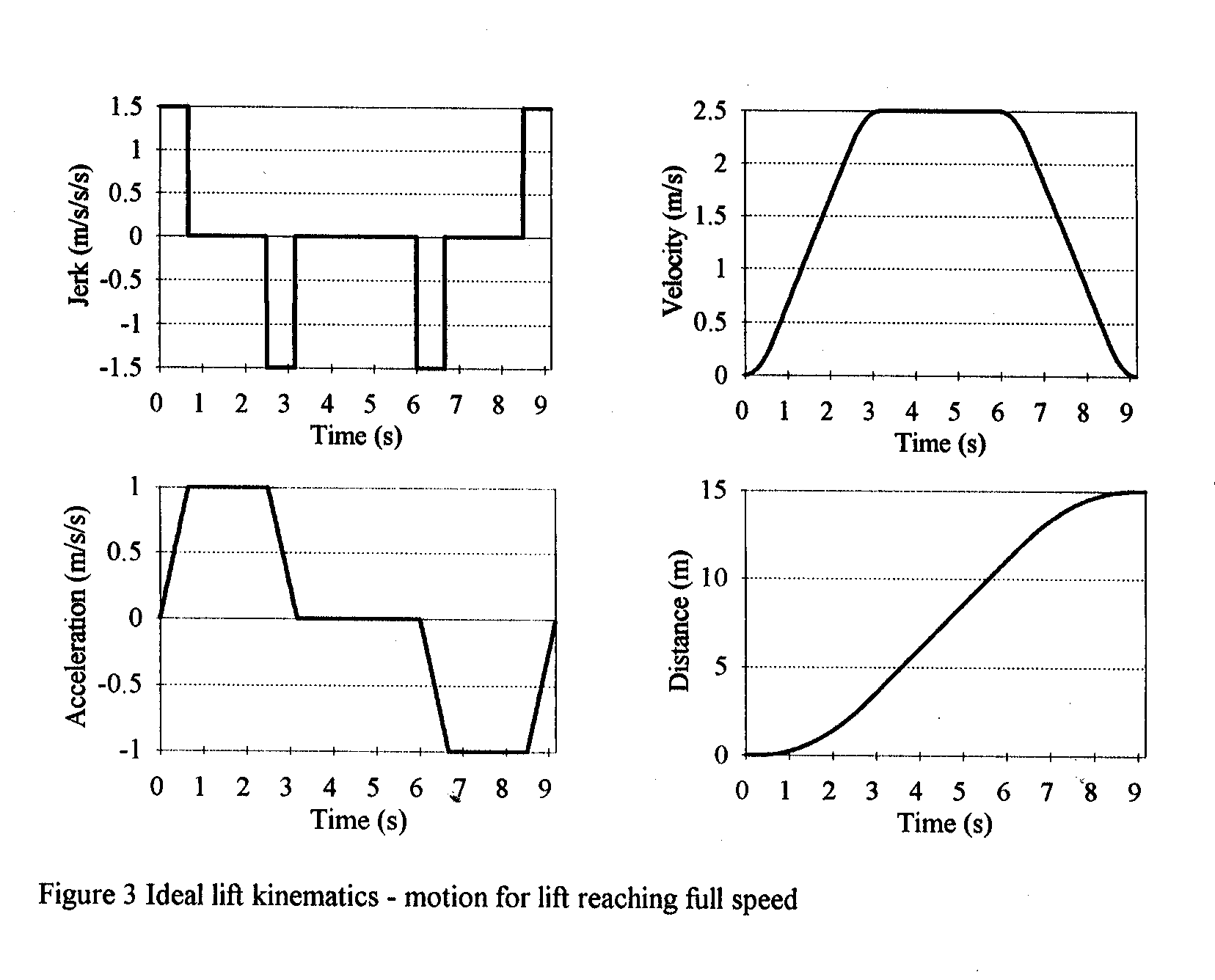
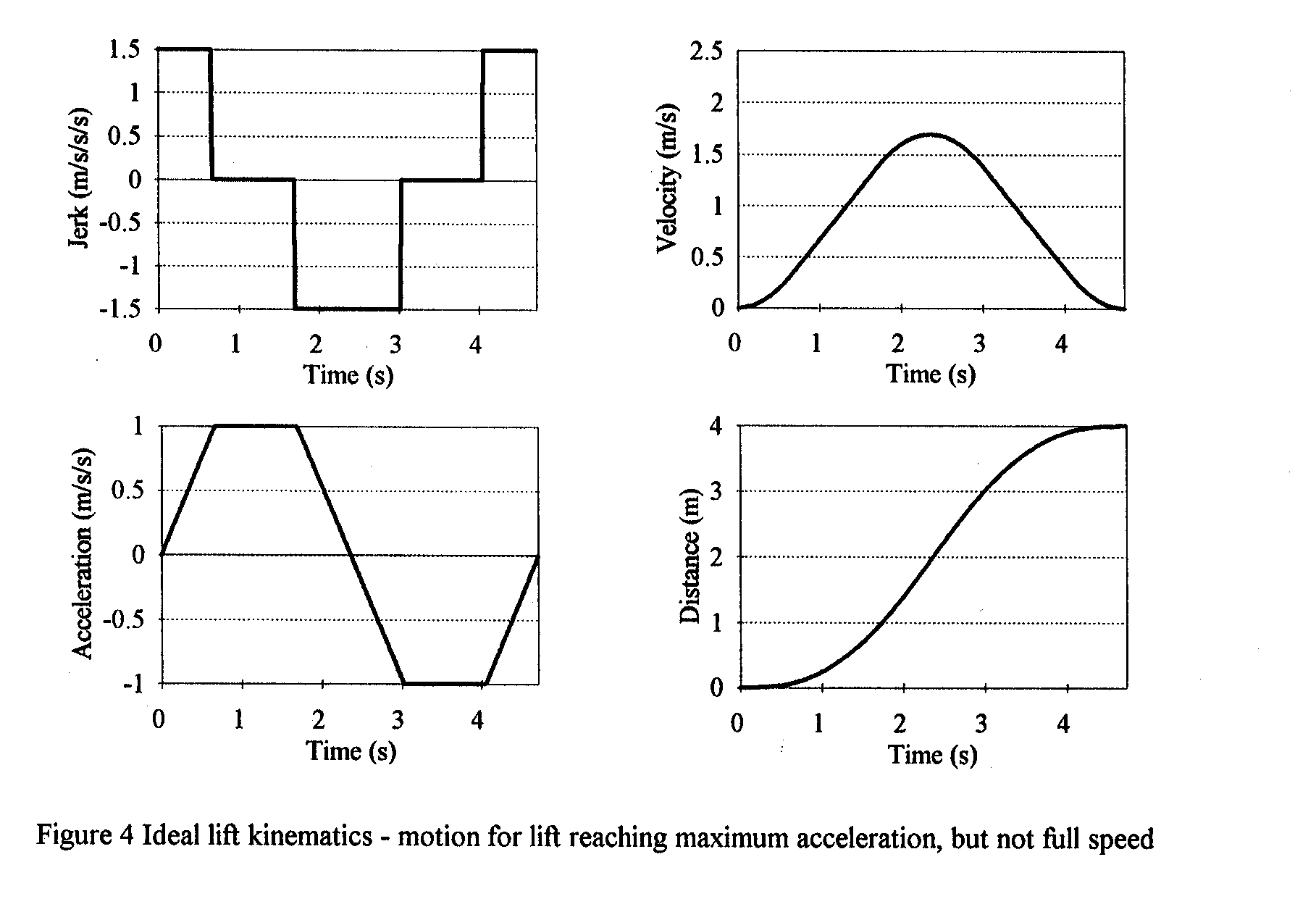
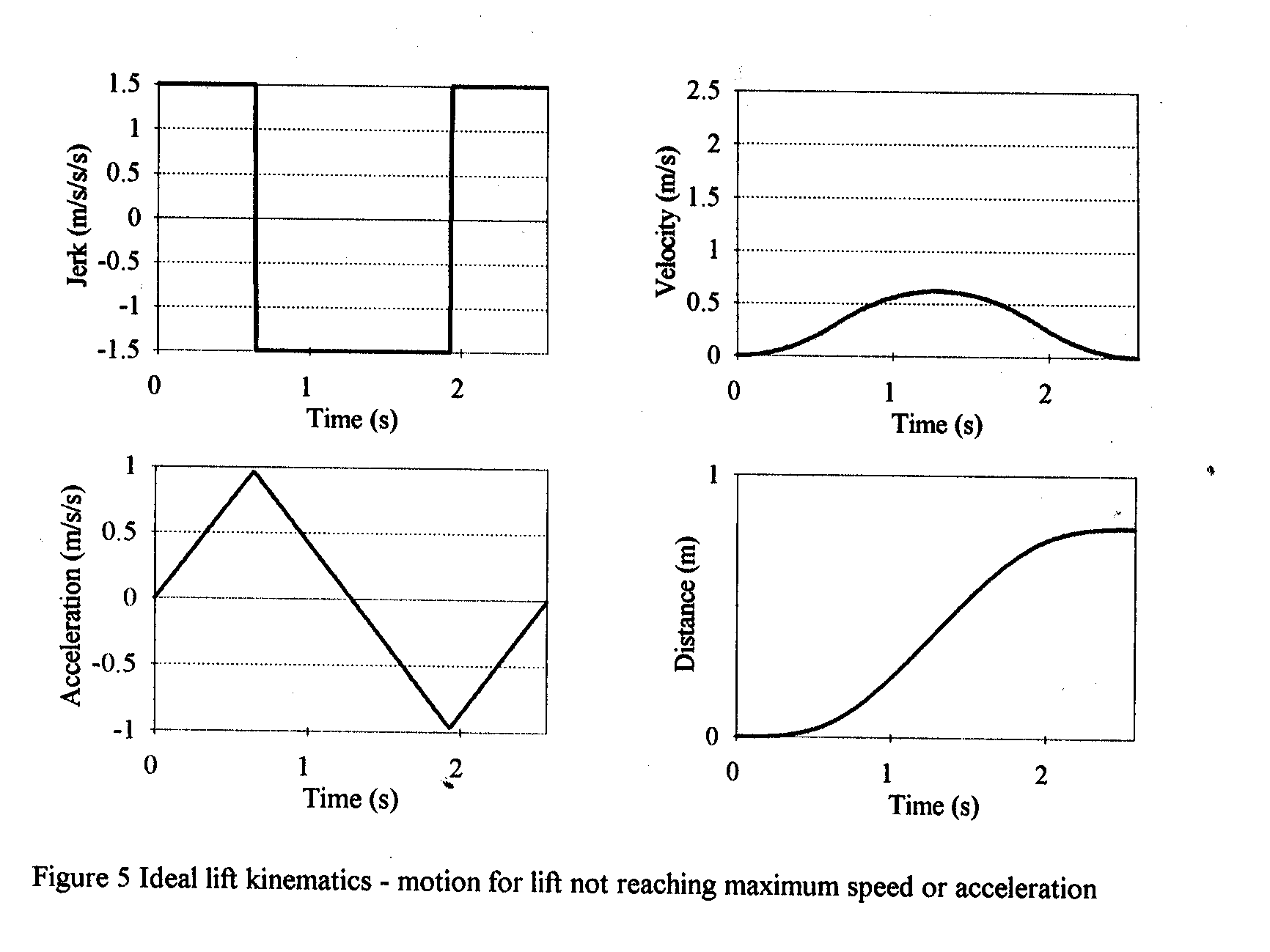
The current stage in this work is the implementation of algorithms calculating the energy consumption associated with the various types of variable speed lift motor drives when input with ideal journey profiles. Other traction and hydraulic drives will also be considered. Once tested and verified against real systems, this will provide the basis for modelling the energy consumption associated with the wide range of lift systems.
Applications for this model will include:
- Investigation of energy savings associated with (i) varying performance (rated acceleration, jerk and velocity) over a round trip according to individual trip distances, and (ii) reducing performance out of peak times when lift traffic is minimal.
- An aid for selection of the most appropriated drive type an rating for a specific installation given energy saving and cost criteria e.g. modern variable frequency systems offer energy savings, but are more expensive initially.
- Simulating and comparing power consumption for a range of system specifications given predicted traffic profiles e.g. are four smaller lifts more or less energy efficient than three larger lifts for a particular building?
- Calculating the energy savings associated with using light modern materials in lift car manufacture as opposed to traditional steel framed cars.
Review of traffic design criteria
Questioning of the current design criteria
Site surveys by the author and other collaborate the view that our standard office lift traffic design criteria are outdated due to changes in working practices and tend to result in the installation of excess handling capacity.
The British Standard design criterion for a single tenancy office building is a morning up peak handling capacity of 17% of the building population in five minutes. The building population is assumed to be 1 person per 10m2. As an example, Figures 6 to 8 record a recent survey in an office building which meets this design criterion. As observed during the survey and demonstrated by the graphs, most of the lifts were empty most of the time, even during the peak periods.
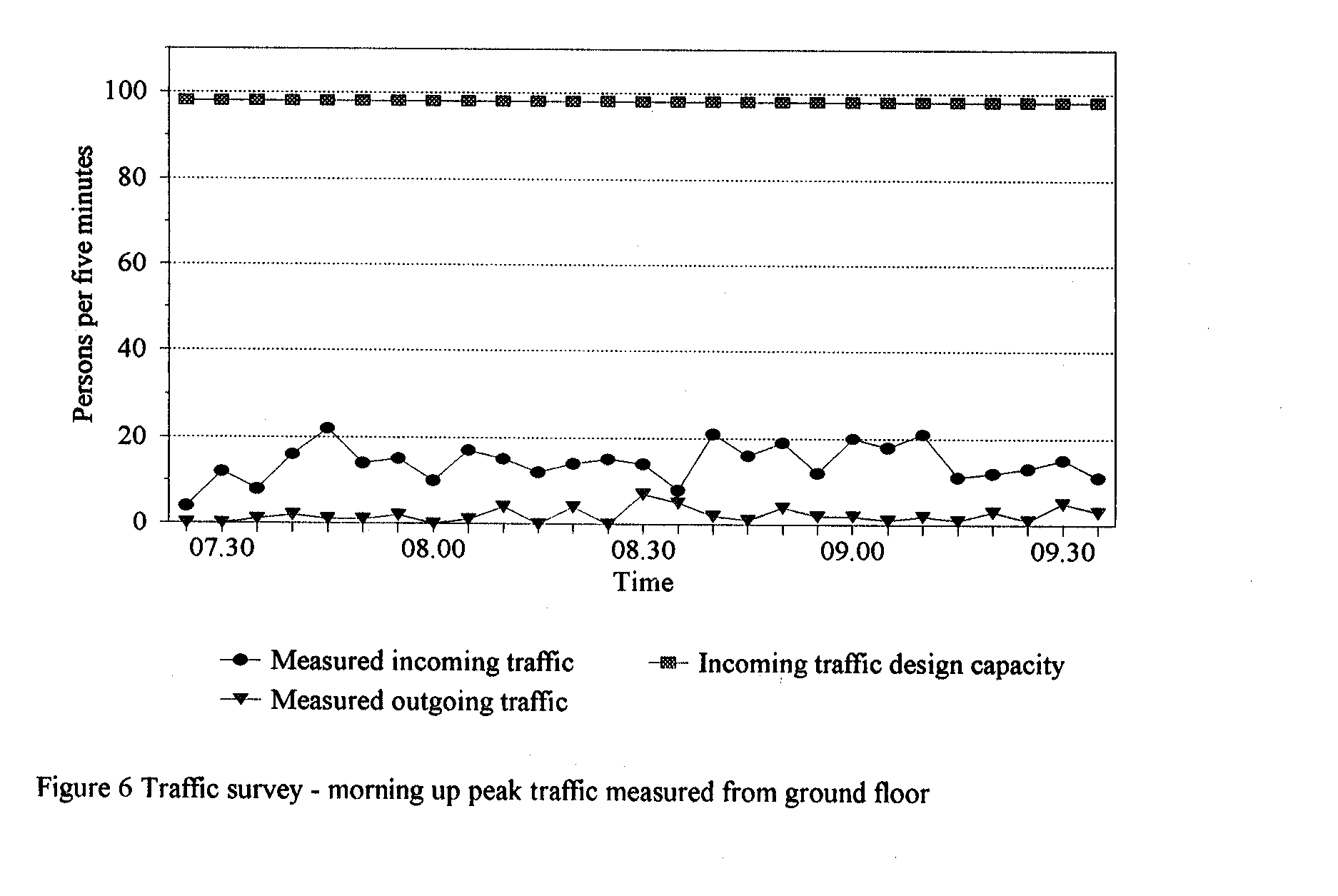

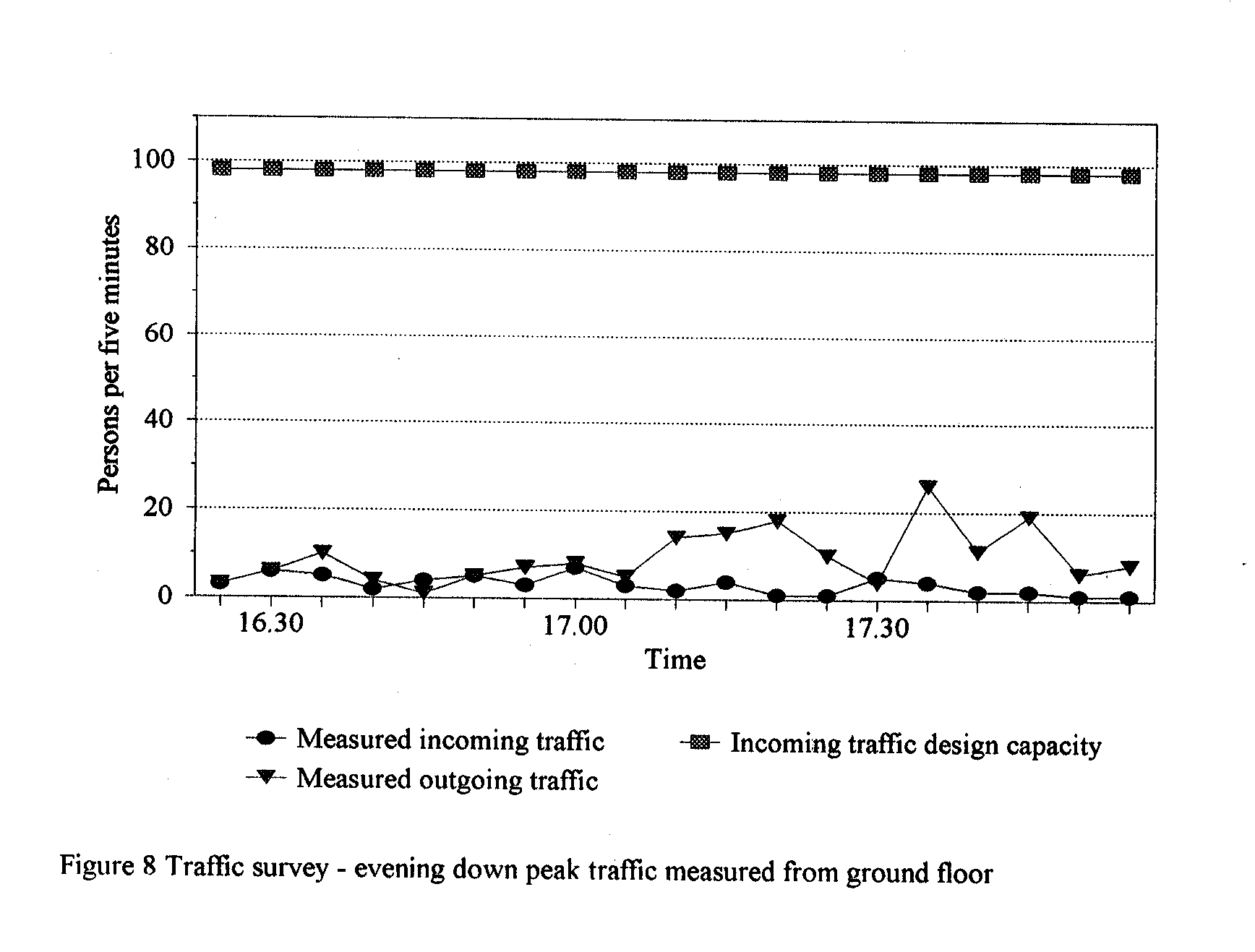
The survey day may have happened to be a quiet day, the building is possible untypical. But the over capacity in this lift system is still a cause for concern. These results, together with evidence from other surveys suggest that there is a basis for questioning our current design criteria, which have been unchanged for years.
The consequence of revising our traffic design criteria would be to avoid excessive over-sizing of lift cars. Moving large, heaving lifts up and down the building when they are virtually empty at peak times is not energy efficient.
Formulating new design criteria
Few designers would accept a few general observations as a basis for reducing their handling capacity design criteria. As part of his research project the author has undertaken to carry out a wide range of lift traffic surveys, the results of which it is anticipated will be published through CIBSE.
Basically there are three approaches that can be taken to traffic surveys:
- Manual counts – the traditional approach, effective but time consuming and tedious. The clipboard and pen can be improved upon now by using a notebook computer to time stamp each event. The survey carried out in Figure 6 to 8 was carried out using a notebook computer.
- Traffic analysers – extrapolating traffic data from information available from the lift control system (lift button presses, etc.). You can purchase traffic analysers which calculate actors such as the average time it takes for a lift to answer a landing call. But no information is known about the number of people waiting or being transported. The author is currently developing a theory which applies a mathematical model to traffic analyser data in order to estimate actual passenger traffic flow in persons per five minutes. The preliminary simplified algorithm is promising and gives results as indicated in Figure 9.
- Computer video counts – this high technology approach (12) to cunting people uses video cameras, frame grabbers and computer based (often neural network) algorithms to determine the number of people using the lifts. This technology is relatively new, but will become more accessible in future years.
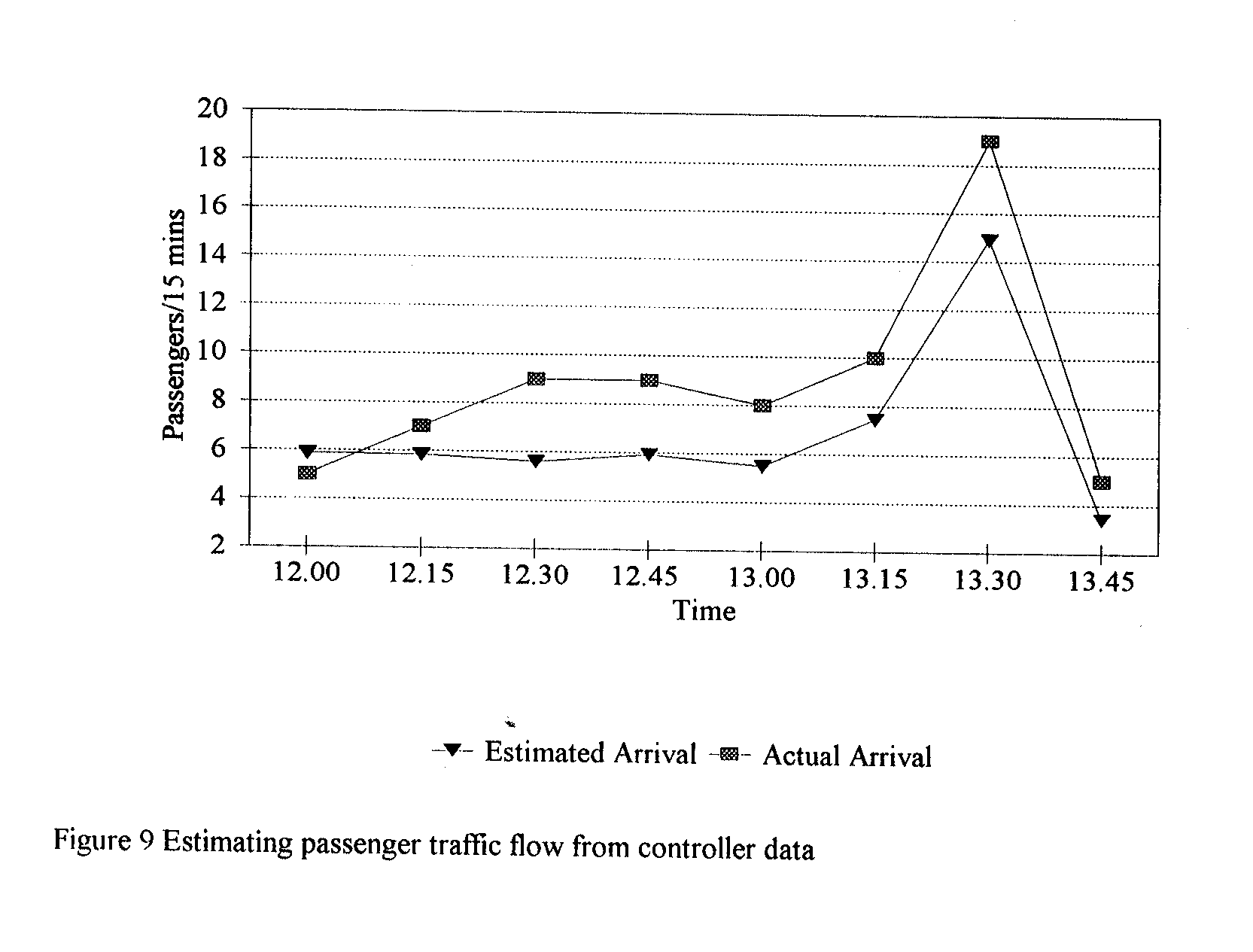
Recent research in small power lads (13)(14) already gives us a range of actual measured office population densities which are summarised in Figure 10. (Reference (13) population densities are not recorded in the report, but were obtained from its authors.). It is envisaged a database of building types and measured population density will be delivered.
Other ways to reduce lift traffic design criteria
The Architect and Engineer can significantly reduce lift passenger traffic with careful consideration of the relative locations of main/floor entrances, lifts, stairs and staff restaurants, etc.If the stairs are well sited and easily accessible, they will be used. In a recent survey, the author noted that over 50% of incoming traffic in a six storey London office building took the stairs in preference to the lifts during the morning up peak. The lift service was excellent by British Standard criteria, but people generally preferred to take the stairs and not to wait at all.
Green lift control algorithms
In another London office building survey, pressing a landing call button on the upper floors on several occasions resulted in two lifts arriving simultaneously to answer the single landing call. A quick response to the call was guaranteed, even if one lift stopped en route to answer another call. But the control system was inherently energy inefficient.
Lift control algorithms generally give consideration to optimisation of traffic flow, and to minimisation of waiting and journey times. But we should also consider criteria for energy consumption. For instance, the environmentally friendly lift control algorithm may deliberately choose to send a single lift to answer a series of calls even if the calls could be serviced more quickly by sending two or more lifts.
A greater knowledge of actual traffic profiles will improve decision making when lifts are allocated to landing calls. When traffic is light, lift speed, acceleration and jerk may be reduced to save energy while maintaining acceptable waiting and journey times for passengers.
Conclusion
At the time of writing the author is in the first year of a four year research programme, so final conclusions and recommendations cannot be made. However, the source of dominating environmental burden associated with lift systems is clear. And pssible ways of reducing that burden have been proposed.
Acknowledgements
The author would like to thank his supervisors, lecturers and colleagues at Brunel University, Ove Arup & Partners and the CIBSE Lift Group for sharing their knowledge and experience which are providing an excellent basis for research in this field.
The author acknowledges with gratitude the financial support for his research from the Engineering and Physical Sciences Research Council, The Ove Arup Partnership, and the Chartered Institution of Building Services Engineers.
References
- ‘Life Ever After’, The Economist, 9 October 1994, 107
- Peters, R. 1994 ‘Hypothetical lift life cycle analysis’, Brunel University/Arup Research & Development, Report No. \engd\511.
- ‘Life cycle inventory analysis computer model (PEMS)’, Pira International, Leatherhead, Surrey, England
- ‘CIBSE Energy Efficiency Guide’, (26 January 1994 draft), section 3.9,1.
- Day, P., and Barney, G., 1993 ‘Computer programmes and their evaluation’, ‘CIBSE Guide D Transportation systems in buildings’, section 11,1.
- Roschier, N., and Kaakinen, M., 1980, ‘New formulae for elevator round trip time calculation’ Elevator World 28(8) (supplement), 1.
- Schroeder, J., 1987, ‘Elevator trip profiles’, Elevator World 35(10), 10.
- Barney, G., and Loher, A., 1990, ‘Elevator Electric Drives’, Ellis Horwood, Chichester, England
- Motz, H., 1976, ‘On the kinematics of the ideal motion of lifts’ Foerden und haben 26(1), 38. (in Germany)
- Motz, H., 1991, ‘On ideal kinematics of lifts’ Elevatori1/91 & 2/92, 41 & 39 (in English and Italian)
- Peters, R., 1993, ‘Ideal Lift Kinematics: Formulae for the equations of motion of a lift’, Brunel University/Arup Research & Development, Report No. \engd\342.
- Schoefiled, A., Stonham, T., and Mehta, P., 1994, ‘Automated people counting using image processing and neural network techniques’, Proceedings of 3rd International Confernece, ‘Automation , Robotics and Computer Vision’.
- Parsloe, C., and Hejab, M., 1992, ‘Small Power Loads’, BSRIA Technical Note TN 8/92, ISBN 0 86022340 X.
- LoPinto, A., Farnfield, T., and Earmes, J., 1993, ‘An Assessment of Small Power Loads for Commercial Buildings’, Stanhope Position Paper.

